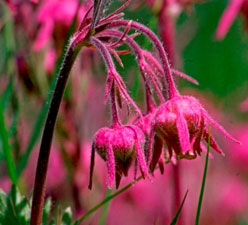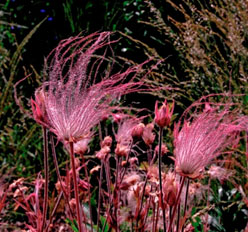Prairie Smoke in the Landscape


Stephen Love, University of Idaho
Scientfic Name: Geum TriflorumCommon Name: Prairie Smoke, Prairie Duster, Old Man’s Whiskers
Description: Prairie smoke is a small, herbaceous, somewhat short-lived perennial. The plants are weakly rhizomatous and slowly increase in size over time. Bright green, feathery, fern-like leaves are an attractive feature of the plant. Nodding pink flowers grow on short stems. Once bloom is complete, the flower heads turn upright and develop feathery plumes, keeping the plants attractive for much of the summer. Bloom period May and June but can be extended into August with supplemental irrigation. Prairie smoke makes a good subject for a moderately xeric rock garden, low bed, or border. This species can be used effectively as a groundcover or wildflower element in a meadow.
Native Habitat: Geum triflorum is widespread throughout the western US and constitutes a part of many plant communities, including meadows, streambanks, sagebrush, and talus slopes. Prairie smoke can be found at elevations ranging from 4,900 to 11,500 feet.
Cultural Requirement
Soil: Tolerates a wide range of soils types, including clay and those with high pH, but does best under well-drained conditions.
Moisture Tolerance: Thrives under a wide range of conditions, from moderately moist to dry. Blooms best when provided with supplemental water.
Sun/Shade/Preference: Grows well and blooms adequately in full sun or in light, partial shade.
Transplanting: Easy to transplant, both from pot to pot and from pot to garden. Withstands long-term culture in pots up to one gallon size.
Propagation: Best grown from seed. A minimum 30-day cold stratification is required for optimal germination. A high rate of germination is normal. Once emerged, seedlings are easy to handle and they transplant satisfactorily when they have 4 to 5 true leaves. Plants can also be propagated by division.
Maintenance (pruning, fertilization, deadheading, division, irrigation, etc): Prairie smoke is almost maintenance free. Apply supplemental irrigation if the leaves begin to show signs of stress. A low rate of fertilizer can help invigorate older plants.
Insect, disease, or other problems: Prairie smoke is commonly infested by aphids but they seldom need control measures.
Landscape Value
Use in the Landscape: Prairie smoke is a versatile plant and can serve many functions. It makes a beautiful groundcover and can be planted between flagstones. It makes a good rock garden plant and is effective planted in the front of low beds and borders. Valuable as a prairie component. Prairie smoke complements other plants in a decorative pot. Amenable to either formal or naturalized designs and can be incorporated almost anywhere a small plant is required.
Weediness/Invasive Potential: Prairie smoke spreads slowly from short rhizomes but is not aggressive. It rarely produces volunteer seedlings. This species does not exhibit invasive behavior.
Foliage: The foliage of prairie smoke is stemless with leaves flaring out from a short crown. The leaves are bright green, semi-evergreen, often hairy, feathery, deeply incised and fern-like.
Flower: The unusual flowers are globular with short pink bracts and petals. Three nodding flowers are produced on each stem. Once bloom is complete, the flower heads turn upright and produce feathery, pink plumes that remain attractive for several weeks.
Timing: May - August
Fruit: The fruits are clusters of plume-tipped achenes. Many single-seeded fruits are produce by each flower.
Form: The form prior to bloom is a crowded mat or low mound. In bloom the plants take on a low vertical form.
Texture: Fine.
Ultimate Size: Prior to bloom, the plants are up to 6 inches tall and a foot wide. In flower the plants are up to 15 inches tall, although many ecotypes remain much shorter.
Rate of Growth: Prairie smoke plants are relatively fast growing and develop an attractive leaf mound within a few months. They often bloom the first year after transplanting to the garden.
Suggested Plant Partners: Plant prairie smoke in meadows with a variety of short grass and wildflower species. If intended for groundcover, plant with one of the common species of Antennaria. In beds and borders, plant with small-statured, moderately xeric plants, such as Campanula rotundifolia, Fragaria virginiana, Festuca idahoensis, Erigeron divergens, and Calylophus serrulatus.
Availability: Occasionally available as potted plants from local or mail-order nurseries specializing in native plants. Seed can be purchased from native plant seed suppliers.
Cultivars: None.
References:
Busco, J. and Morin, N.R. 2003. Native Plants for High Elevation Western Gardens. Fulcrum Publishing, Golden, CO
Mee, W., Barnes, J., Kjelgren, R., Sutton, R., Cerny, T. and Johnson, C. 2003. Water Wise: Native Plants for Intermountain Landscapes. Utah State University Press, Logan, UT.
Meyer, S., Kjelgren, K.K., Morrison, D.G. and Varga, W.A. 2009. Landscaping on the New Frontier. Utah State University Press, Logan, UT.
Robson, K.A., Richter, A. and Filbert, M. 2008. Encyclopedia of Northwest Native Plants for Gardens and Landscapes. Timber Press, Portland, OR.

